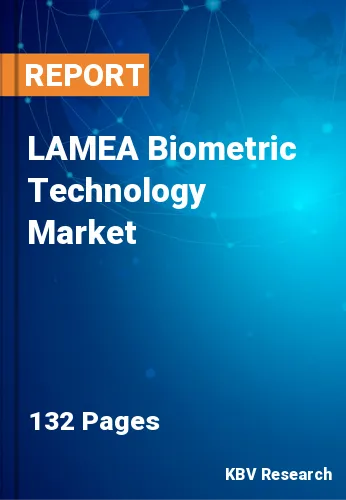The Latin America, Middle East and Africa Biometric Technology Market would witness market growth of 18.4% CAGR during the forecast period (2021-2027).
While the underlying mechanisms for biometric authentication are sophisticated, they are remarkably simple and rapid for users on the surface. It's faster to put a finger on a scanner and unlock an account in seconds than it is to type out a long password with several special characters. Furthermore, most users end up making the common error of forgetting their password. Biometric authentication necessitates the presence of the user's input at the time of permission. A physical biometric cannot be transferred or shared digitally; most biometric authentication methods need to be used with a physical application.
Biometrics technology is being implemented for e-passport programs and to trace the cases of illegal immigration. Biometrics applications are being increasingly adopted by end-user and therefore it is expected that the market size will boom in the upcoming years. There is a growing demand for such security solutions and technologies due to the fact that this technology offers increased convenience, secure identity management, and superior human resource management to the companies. Traditional security methods which typically rely on passwords, PINs, or smart cards are known to be sluggish, less convenient, and less reliable than biometric solutions.
The United Arab Emirates (UAE), a modern state with a high level of life, is considered as one of the world's most important trading and business hubs. As a result, the country sees a steady influx of migrants entering its borders on a daily basis. Proper and effective border control is more important than ever as the government aims to diversify the economy and promote the UAE as a worldwide commerce and tourism hub. The biometrics market in the United Arab Emirates (UAE) is expected to witness a significant growth. This is because the infrastructure and construction markets are expanding in the region. The United Arab Emirates already has the world's largest biometric database, with over 135 million residents' fingerprints, hand/palm prints, and facial photos.
The Brazil market dominated the LAMEA Biometric Technology Market by Country 2020, and would continue to be a dominant market till 2027; thereby, achieving a market value of $1,693.3 million by 2027. The Argentina market is exhibiting a CAGR of 19% during (2021 - 2027). Additionally, The UAE market would experience a CAGR of 18.1% during (2021 - 2027).
Based on Type, the market is segmented into Physiological Biometrics and Behavioral Biometrics. Based on Physiological Biometrics Type, the market is segmented into Face Recognition, Fingerprint Recognition, Iris Recognition, Hand Geometry, and Others. Based on Behavioral Biometrics Type, the market is segmented into Signature Recognition, Voice Recognition, and Others. Based on Component, the market is segmented into Hardware and Software. Based on End User, the market is segmented into Public Sector, BFSI, Healthcare, IT & Telecom, and Others. Based on countries, the market is segmented into Brazil, Argentina, UAE, Saudi Arabia, South Africa, Nigeria, and Rest of LAMEA.
Free Valuable Insights: The Global Biometric Technology Market is Predict to reach $85 Billion by 2027, at a CAGR of 14.1%
The market research report covers the analysis of key stake holders of the market. Key companies profiled in the report include NEC Corporation, Thales Group S.A., Fujitsu Limited, ImageWare Systems, Inc., Precise Biometrics AB, BIO-key International, Inc., Secunet Security Networks AG, Suprema, Inc., IDEMIA SAS, and HID Global Corporation.
By Type
By Component
By End User
By Country
Our team of dedicated experts can provide you with attractive expansion opportunities for your business.

